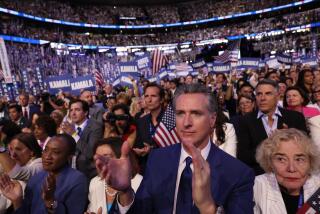5 takeaways from the California governor’s race
Republican, independent voters still relevant in governor’s race
Democratic leaders may hold up the Golden State as the center of the country’s resistance to President Trump, but they can’t write off California’s Republican and independent voters. Despite limited money and little name recognition, John Cox got 40.6% of the vote in Tuesday’s election. That number could change as provisional and late mail-in ballots are counted, but it’s in line with previous Republican gubernatorial candidates including Neel Kashkari (40%) and Meg Whitman (41%) in their bids.
Cox was able to hit 40% despite falling Republican Party registration in California. The party has steadily declined over the last two decades, falling to 24% of the state’s registered voters compared with 35% in 2002, while no party preference registration grew 12% over the same period.
Lopsided spending defined race, helping Newsom
Unrelenting television spots helped Gavin Newsom’s campaign spread his positive and progressive message, but Cox didn’t have the money to reach the same number of people.
Major Republican donors in California bypassed him this election season, and his campaign raised about $17 million, which includes $5.7 million of his own money, and an outside committee backing him spent $430,0000. By comparison, Newsom raised more than $58 million, while outside groups spent more than $12 million supporting the lieutenant governor.
A multimillionaire, Cox could have spent more of his personal fortune, but he said in an interview that he and his wife, Sarah, had agreed on a predetermined amount of money he would spend during the race.
California’s homelessness and housing crises were focuses of the campaign
No previous governor’s race in recent years has seen housing and homelessness play such a central role. Despite their ideological issues, Newsom and Cox made housing affordability a focal point of their respective campaigns, elevating the issue. Newsom talked about economic inequality, while Cox emphasized housing prices.
California is home to nearly half of all unsheltered people in the country — about 91,000 — and as Newsom and Cox traveled the state, they were confronted by the crisis in cities with large homeless populations.
California voters are angry at Washington, D.C., not Sacramento
While Cox sought to blame California’s woes on Newsom and the “political class,” the election results showed that voters want change in Washington, not Sacramento.
National issues helped shape the race as Newsom and Cox were confronted with reporters’ questions about immigration, the U.S. Supreme Court nomination of Judge Brett M. Kavanaugh and President Trump’s latest tweet. Newsom’s campaign focused on attacking Trump administration policies on healthcare and immigration, a strategy that galvanized anxious and frustrated California Democrats.
Trump was a factor in how California voted in the governor’s race
An AP VoteCast exit poll of California voters found two-thirds said Trump was a factor in how they voted. That wasn’t good news for Cox, since the poll found that 67% of voters disapproved of the job Trump has done as president. Newsom has long been an antagonist of Trump while Cox was endorsed by the president.
Here’s a sampling of other findings in the exit poll:
- Newsom was the choice of voters who disapproved of Trump, and Cox dominated among those who approved of the job Trump was doing.
- Newsom was heavily favored by women while men were evenly split between the two candidates.
- Newsom also was the top choice among all age groups except for those 65 years old and over — he was neck-and-neck with Cox with those voters.
- White voters were evenly split between Newsom and Cox, but Newsom dominated among Latinos, African Americans and Asian Americans.
- Cox was the top choice, by six percentage points, among California voters not affiliated with either the Democratic or Republican parties. As expected, Newsom did well with registered Democrats and Cox with registered Republicans.
- Voters who believed that immigration, taxes, the economy and jobs were the most important issues facing the country favored Cox. Those who thought healthcare, the environment and gun policy were the most important issues favored Newsom.
More to Read
Get the L.A. Times Politics newsletter
Deeply reported insights into legislation, politics and policy from Sacramento, Washington and beyond. In your inbox three times per week.
You may occasionally receive promotional content from the Los Angeles Times.












